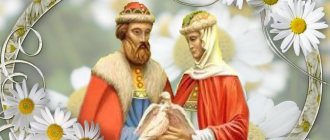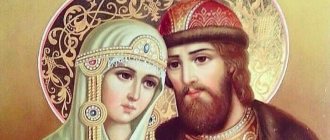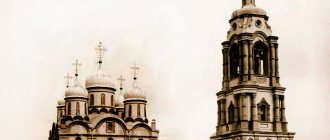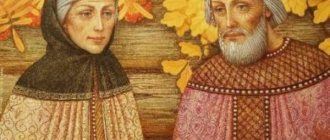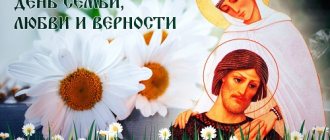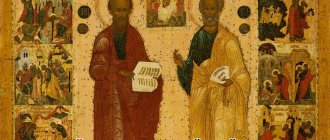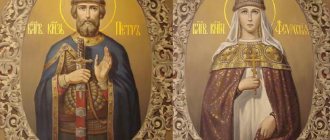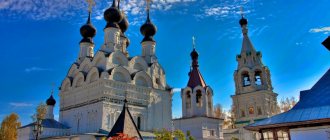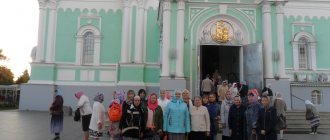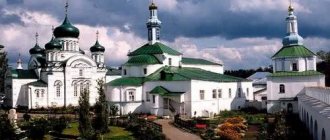In the glorious city of Murom, known since ancient Russian times, the famous women's Holy Trinity Monastery is located. And first of all, it is known for the fact that for some time now it has kept the relics of the famous Murom saints Peter and Fevronya, who in Russia began to be revered as patrons of family and marriage. And the question immediately arises quite logically: “Where is the city of Murom located?” This city stands on the left bank of the Oka and belongs to the Vladimir region, bordering the Nizhny Novgorod region, 300 km from Moscow, with a population of just over 100 thousand people.
History of the monastery
Getting to the topic: “Murom: the monastery of Peter and Fevronia,” let’s plunge a little into the ancient history of Rus'. This monastery was founded by the Murom merchant Tsvetnov Tarasy Borisovich in 1643. Previously, during the period of the 11th-13th centuries, an old settlement with a wooden cathedral of the holy princes Boris and Gleb was located on this site; a little later, the Holy Trinity Church was built here from wood.
Thanks to the efforts and hard work of the merchant Tsvetnov, who received the blessing of the Bishop of Ryazan and Murom, in 1643, instead of a wooden church, the White Stone Holy Trinity Cathedral was erected on this site, which has survived to this day.
The queue to the relics of the patron saints of the family Peter and Fevronia will begin to form on July 15 from the Park Kultury metro station and will pass along Prechistenskaya Embankment and Soimonovsky Proezd, according to a statement from the press service of the Patriarch of Moscow and All Rus', published on Saturday.
“From July 15, 2022, from 8:00 to 20:00, the queue for the relics of the Holy Princes Peter and Fevronia will form on Prechistenskaya Embankment from the Crimean Bridge. You need to move along the embankment, Soimonovsky Proezd, and then along Volkhonka Street to the main entrance to the Cathedral of Christ the Savior."
, the message says.
The organizers clarified the procedure for the movement of buses with pilgrims from the regions, which, according to a preliminary application to the headquarters of the organizing committee, will be assigned to parking on Frunzenskaya Embankment; travel by bus to the Cathedral of Christ the Savior will be limited.
The relics of the patron saints of marriage, the blessed princes Peter and Fevronia of Murom, will be delivered on July 14 for a week from Murom to Moscow for the veneration of believers. The meeting of the shrine will be led by Patriarch Kirill of Moscow and All Rus': the service will begin at 15.00, admission is free. Pilgrims will have access to the temple from July 15 to 21 from 08.00 to 20.00, and a press center will operate here on the same days.
The Russian Orthodox Church honors the memory of the Murom holy spouses Peter and Fevronia, who lived at the turn of the 12th-13th centuries, on July 8 and September 19. Their marriage is an example of Christian marriage; saints have long been revered in Rus' as patrons of married life.
According to the ancient Russian chronicle, the daughter of a beekeeper from the Ryazan village Fevronia cured the Murom prince Peter of a terrible illness, after which they fell in love and got married. In old age, the couple took monastic vows and bequeathed to be buried together. Peter and Fevronia died on the same day and hour - July 8, new style. The relics of the saints are in the Holy Trinity Convent in Murom.
Since 2008, Russia has celebrated the Day of Family, Love and Fidelity on the day of the patrons of marriage.
/
Saturday, July 13, 2022
/ topics:
Church Parking Garden Ring Marriage and Fidelity Day
|
The Russian Orthodox Church has published a route for access to the relics of Peter and Fevronia in Moscow
….. © Press service of the Patriarch of Moscow and all of Russia Scheme of passage to the relics of Peter and Fevronia in Moscow. July 15-21, 2022 © Press service of the Patriarch of Moscow and All Rus' Scheme of passage to the relics of Peter and Fevronia in Moscow. July 15-21, 2022 The organizers clarified the order of movement of buses with pilgrims from the regions, which, according to a preliminary application to the headquarters of the organizing committee, will be assigned to parking on Frunzenskaya Embankment; travel by bus to the Cathedral of Christ the Savior will be limited. …..
In Moscow, pilgrims were told where to queue for the relics of Peter and Fevronia
Those wishing to touch the relics of the holy princes Peter and Fevronia of Murom will be able to line up on Prechistenskaya Embankment starting at 8:00 on July 15, the press service of the organizing committee of the Moscow Seasons series of city street events said in a statement.
From the Holy Trinity Convent of Murom on July 14, the relics of the holy saints Peter and Fevronia, patrons of marriage, will be brought to the capital's Cathedral of Christ the Savior. They will stay in Moscow until July 21.
…..
Further, the route involves moving along Prechistenskaya Embankment from the Crimean Bridge - along Soymonovsky Proezd - along Volkhonka Street - to the central entrance to the Cathedral of Christ the Savior.
Buses with pilgrims from the regions, according to a preliminary application, will be parked on Frunzenskaya Embankment. Bus travel to the Cathedral of Christ the Savior will be limited.
Pilgrims will have access to the relics daily from July 15 to 20 from 8:00 to 20:00.
Every believer has the opportunity to take part in a unique event - the bringing of the entire reliquary with the relics of the holy noble princes from Murom and a solemn prayer service before their honorable relics, which will be led by Patriarch Kirill on July 14 at 15:00. Admission to the prayer service in the Cathedral of Christ the Savior is free.
The Russian Orthodox Church called on Orthodox Christians to honor the relics of Peter and Fevronia in Moscow
The Patriarchate of the Russian Orthodox Church reported how access for believers to venerate the relics of Saints Peter and Fevronia of Murom in the Cathedral of Christ the Savior will be organized.
…..
It is assumed that the queue will start from the Kropotkinskaya metro station, but with an increase in the number of pilgrims, it may begin to form from the Park Kultury metro station.
…..
The Russian Orthodox Church honors the memory of the patrons of family and marriage on July 8. …..
The priest of the Russian Orthodox Church told why one should come to the relics of Saints Peter and Fevronia
The priest of the Russian Orthodox Church, Archpriest Andrei Tkachev, said that it will be possible to venerate the relic - the relics of Saints Peter and Fevronia of Murom - starting from July 15.
This Sunday, July 14, the relics of Saints Peter and Fevronia, patrons of marriage, will be delivered to the Cathedral of Christ the Savior. The meeting of the relics and the festive prayer service at 15:00 in the Cathedral of Christ the Savior will be led by His Holiness Patriarch Kirill of Moscow and All Rus'. Anyone can visit it.
Starting Monday, July 15, at 8:00 am, pilgrims will be allowed into the temple to venerate the relic. …..
“The vast majority of people’s problems are related to family. Accordingly, they will come and ask Peter and Fevronia for peace with mothers-in-law and mothers-in-law, sons-in-law and daughters-in-law, childbirth, illnesses of offspring and other whirlwinds. They will, of course, seek happiness, beg for help in finding a soul mate or reconciling with the existing one.”
, Andrey Tkachev shared
Let us remind you that the Orthodox Church honors the memory of the Murom saints Peter and Fevronia, who lived at the turn of the 12th-13th centuries, and considers their marriage a model of Christian marriage.
…..
The relics of the patron saints of the marriage of Peter and Fevronia will be brought to Moscow
On July 14, the relics of the patron saints of the marriage of Peter and Fevronia will be brought to Moscow from Murom with the blessing of Patriarch Kirill of Moscow and All Rus'. This was reported on Friday, July 12, by the press service of the Moscow Patriarchate.
The relics will be in the Cathedral of Christ the Savior from July 15 to 21. Access to them will be open from 8:00 to 20:00 Moscow time, NSN reports.
The meeting of the relics of the family's patrons will take place in the temple on July 14. The festive service will be led by Patriarch Kirill. Starts at 15:00, admission will be free.
In the Russian Orthodox Church (ROC), the marriage of the Murom princes Peter and Fevronia, who lived at the turn of the 12th-13th centuries, is an example of Christian marriage.
Murom prince Peter and the daughter of a beekeeper from the Ryazan village Fevronia got married and lived in love all their lives. The princely couple took monastic vows in old age. The couple bequeathed to bury them together. …..
July 8 has been declared by the Russian Orthodox Church as a day of remembrance for the Murom patrons of the family, the website aif.ru clarifies.
In 2008, the Federation Council approved the initiative to establish a new state holiday on July 8 - the All-Russian Day of Love, Family and Fidelity.
In March, particles of the relics of Saints Peter and Fevronia of Murom were delivered to Ulyanovsk. Also brought to the city was an icon of the Mother of God “Sorrowful” with a piece of the robe of the Virgin Mary.
On July 12, Orthodox Christians celebrate the day of the apostles Peter and Paul, who are one of the most famous preachers of the teachings of Jesus Christ.
The relics of Saints Peter and Fevronia of Murom will be brought to Moscow on Sunday
…..
“From July 14 to July 21, 2022, the relics will remain in the Cathedral Cathedral of Christ the Savior. ….. The service begins at 15:00. Free admission.
….. Their marriage is a model of Christian marriage. Saints Peter and Fevronia were revered in Rus' as the patrons of married life.
…..
One exit of the Kropotkinskaya metro station will be closed due to the queue to the relics of Peter and Fevronia
While the relics of Saints Peter and Fevronia are in the capital's Cathedral of Christ the Savior, the city authorities plan to close one of the exits of the Kropotkinskaya metro station in the event of a large number of people wishing to venerate the shrine, RIA Novosti reports.
…..
“The exit from the Kropotkinskaya metro station to the park area of the Cathedral of Christ the Savior will be closed. You can enter the cathedral from Volkhonka Street through the central entrance. If there are a large number of people wishing to visit the temple, the Patriarchal Bridge may be closed.”
, said a representative of the press service of the capital’s department of regional security and anti-corruption.
He clarified that the lift for people with disabilities is temporarily out of service due to repairs. You can get inside the temple by elevator from the lower floor, the entrance to which is located in Soimonovsky Proezd. Volunteer work will also be organized there.
The safety of pilgrims will be ensured by employees of the Internal Affairs Directorate for the Central Administrative District, the National Guard, the Ministry of Emergency Situations of Russia and private security organizations. In addition, an ambulance will be on duty near the temple.
…..
The relics of Peter and Fevronia were brought to the Cathedral of Christ the Savior in Moscow
The relics of Saints Peter and Fevronia, patrons of marriage, arrived in Moscow; they were brought for veneration at the Cathedral of Christ the Savior, a RIAMO correspondent reported on Sunday.
In the Cathedral of Christ the Savior, a solemn prayer service began in front of their honorable relics, led by Patriarch Kirill of Moscow and All Rus'. Admission to the prayer service is free; at the moment, a large number of believers from different cities of Russia have already gathered.
…..
A priest of the Russian Orthodox Church spoke about the true purpose of contact with the relics of Saints Peter and Fevronia
On Sunday, July 14, the relics of Saints Peter and Fevronia, who, as is known, are the patrons of family and marriage, will be brought to Moscow. According to the press service of Patriarch Kirill of Moscow and All Rus', from July 15, pilgrims will be allowed to visit the Orthodox shrine, which will be located in the Cathedral of Christ the Savior, and will be able to venerate the relic. ….. Pilgrims will be allowed to the shrine during the week from 8:00 to 20:00. The priest of the Russian Orthodox Church, Archpriest Andrei Tkachev, told us what the true meaning of the pilgrimage to the relics of saints is and what prayers should be said when coming into contact with them, and in particular about what prayers are usually addressed to Saints Peter and Fevronia. “If we are talking about the faithful princes of Murom, then we will obviously be talking about the full range of family issues. After all, if you remove all the troubles with relatives from life, then it will become like paradise. ..... They will, of course, seek happiness, pray for help in finding a soul mate or reconciling with the existing one,” shared Andrei Tkachev. At the same time, believers will not need to make any preliminary preparations when going to the relics of Peter and Fevronia. As Andrei Tkachev explained, the Holy Scripture says that human bodies are the temple of the Holy Spirit. Therefore, coming to the relics of a saint is the same as visiting a church. It is not the whole person who appears before people, but only the bodily shell sanctified by God. …..
The relics of Saints Peter and Fevronia will be brought to Moscow
…..
Since 2008, the day of remembrance of Saints Peter and Fevronia has been celebrated in Russia as the All-Russian Day of Love, Family and Fidelity.
Photo: ok.ru
A hotline has opened for pilgrims to the relics of Saints Peter and Fevronia in Moscow
A hotline has opened for pilgrims to the relics of Saints Peter and Fevronia in Moscow. This was reported in the press service of the organizing committee of the church for the bringing of the relics of Saints Peter and Fevronia.
A hotline has been launched in Moscow for pilgrims to the holy relics of the faithful Prince Peter and Princess Fevronia of Murom. For all questions about the presence of the shrine in Moscow, you can contact the hotline: 8-495-637-12-95, 8-495-637-12-97. Hotline operating hours: from 8:00 to 19:00.
The relics of saints Prince Peter and his wife Fevronia, who lived in Murom at the turn of the 12th-13th centuries, were brought to Moscow on July 14. They will remain in the Cathedral of Christ the Savior until July 21, 2022. The queue for the relics will form on Prechistenskaya Embankment on the side adjacent to the Moscow River.
…..
Relics of Saints Peter and Fevronia met in Moscow
Believers greeted the relics of the patron saints of the family Peter and Fevronia with a solemn prayer service in the Cathedral of Christ the Savior in Moscow. Metropolitan Arseny of Lipetsk and Zadonsk led the solemn prayer service and “with the blessing of the Patriarch” delivered a welcoming speech. “You have the opportunity to touch this shrine in the capital city - Moscow. We are grateful that in recent years special attention has been paid to these miracle-working princes. And we are grateful to both public and government organizations that support this event. I would like to ask these wonderful ascetics, that through their prayers your life, in your family, everything would be safe, so that your family church would never collapse.”
, said Metropolitan Arseny.
“Remembering the importance of preserving family values, with the blessing of Patriarch Kirill, the relics of the saints from Murom were transferred here to the Cathedral of Christ the Savior for a week.
You must venerate this shrine. We pray to the saints to strengthen our family and support our marriage. It is important that we rethink our attitude towards family, marriage - the value that the Lord gives us, connecting us with each other. Family is the basis of society, of our life ,” priest Alexander Volkov, head of the press service of the Patriarch of Moscow and All Russia, told reporters.
“We thank the Moscow city authorities and personally (Mayor) Sergei Sobyanin for the many years of beneficial work that we have been doing together: we have extensive experience in organizing the bringing of relics
,” he added.
In turn, the head of the Moscow Department of Interregional Policy and Interethnic Relations, Vitaly Suchkov, assured that everything was organized for the veneration of the relics of saints. “The city is ready, a headquarters has been created in Moscow to organize access to the relics, medical support has been organized, and public order has been organized.
More than 300 volunteers work. Everything that is needed so that people can calmly come and venerate the relics - everything is organized ,” he said. Suchkov also noted that a separate queue has been organized for disabled people, families with many children and mothers with small children. …..
A hotline has opened for pilgrims to the relics of Saints Peter and Fevronia in Moscow
…..
The relics of Peter and Fevronia are brought to the capital
One of the exits from the Kropotkinskaya metro station to the Cathedral of Christ the Savior will be closed while the relics of Saints Peter and Fevronia are in the temple. This was reported by the press service of the capital’s Department of Regional Security and Anti-Corruption.
In addition, in the event of a large influx of pilgrims, the Patriarchal Bridge may be closed. It is recommended to get to the cathedral from Volkhonka Street.
The lift for people with limited mobility has been taken out of service due to repair work. ….. An ambulance will be on duty at the temple.
….. This was reported by the press service of Patriarch Kirill of Moscow and All Rus'.
….. On this day, the Russian Orthodox Church honors the memory of the patrons of family and marriage.
The relics of Saints Peter and Fevronia will be brought to Moscow
….. The relics will be in the Cathedral of Christ the Savior for a week.
…..
It is specified that citizens will be able to make a pilgrimage to the relics from July 15 to 21 from 8:00 to .....
Hundreds of volunteers will help pilgrims to the relics of Peter and Fevronia in the center of Moscow
The capital's authorities sent about 300 volunteers to help believers who want to venerate the relics of Saints Peter and Fevronia in the Cathedral of Christ the Savior.
This was stated by the head of the Department of National Policy and Interregional Relations of Moscow Vitaly Suchkov. According to him, the city has accumulated solid experience in holding such events and is ready to organize pilgrimages for all categories of the population, while maintaining public order.
“Not every Muscovite, not every person living in Russia, can get to Murom and venerate this wonderful shrine,” noted the press secretary of the Patriarch of Moscow and All Rus' Kirill, priest Alexander Volkov.
According to him, prayers are offered to Peter and Fevronia to strengthen families and support marriage. This is especially true with modern deformations of the main unit of society.
The relics of the saints will be available for veneration from July 15 to July 21. Access is open from 08:00 to 20:00. A queue forms on Prechistenskaya Embankment in the center of Moscow. Depending on the number of believers, it will begin near the Kropotkinskaya or Park Kultury metro stations.
The website of the Moscow.Center newspaper recalls that in the first half of 2019, the capital’s birth rate jumped by six percent.
A priest of the Russian Orthodox Church spoke about the true purpose of contact with the relics of Saints Peter and Fevronia
On Sunday, July 14, the relics of Saints Peter and Fevronia, the patron saints of marriage, will arrive in Moscow. Starting Monday, pilgrims will be allowed to visit the Orthodox shrine, which will be located in the Cathedral of Christ the Savior, and will be able to touch the relic. …..
At the same time, believers will not need to make any special preparations when going to the relics of Peter and Fevronia. …..
As the priest noted, Orthodox Christians come to the relics with the belief that the Lord is alive and the souls of all people live in God. But the souls of saints have active prayer and living love. By coming to their bodies, we come closer to their souls, deserving attention, kissing the relics and worshiping in the hope of being heard.
…..
Peter and Fevronia also died together - on July 8, according to the new style. …..
Photo: novorosinform.org
A hotline has opened for pilgrims to the relics of Saints Peter and Fevronia
….. . ….. Photo: tsargrad.tv
Murom monastery and its decoration
The main decoration of the cathedral were golden forged crosses and glazed tiles with original ornaments, representing the masterpieces of Murom craftsmen of the 17th century. This is what makes this temple different. The style in which it was created is called “Russian patterned”.
In the period from 1648 to 1652, a gate-roofed church of the Kazan Mother of God and a multi-tiered bell tower were built on the same foundation in the southern part of the monastery.
During Soviet times, from 1923, the convent was closed by order of the authorities. In 1975, a wooden church of St. Sergius of Radonezh, which is a monument of wooden architecture of the 17th century, was brought to its territory from the neighboring village of Krasnoye, Melenkovsky district.
Opening of the monastery
On May 15, 1991, a long-awaited event happened: on the day of remembrance of Saints Boris and Gleb, the opening of the Holy Trinity Convent for women took place. And a few days later, on May 22, 1991, nun Tabitha (Golanova), who later became his abbess, arrived here. The Murom Monastery has several farmsteads: Holy Cross (Murom), Bogoroditskoye (village Mishino, Murom district), Bogoroditskoye (Vladimir region, Kameshkovsky district).
In 2001, a boarding house for elderly people and minor children called “Nadezhda” was created in the monastery. Under the patronage of this holy monastery there are also several prisons, a juvenile colony, a military unit and the Phoenix Society for wheelchair users.
Shrines of the monastery
Since its foundation, the convent has kept the Vilna reliquary cross, which was one of the first shrines of the monastery. On May 15, 1996, on the anniversary of the founding of the monastery, the ancient shrine was returned from the city historical museum.
But the main shrine for this convent was the relics of the blessed saints Peter and Fevronya. They were transferred from the local museum on September 19, 1992. Historical information indicates that until 1921 they were located in the local Nativity Cathedral. The monastery also keeps the staff of the virtuous Ripsimiya (Slyunyaeva), who became the last abbess before the closure of the monastery in 1923.
Returning to the topic “Murom: the monastery of Peter and Fevronia,” it should be noted that in honor of the great saints Peter and Fevronia, a chapel was built on the territory of the monastery.
There are three churches in the convent: St. Sergius-Trinity Cathedral, Church of the Kazan Icon of the Mother of God (1648), Church of St. Sergius of Radonezh (1715).
The main one is St. Sergius Trinity Cathedral. And it, in turn, is divided into three altars: the central one - in honor of the Holy Great Trinity, the right one - in honor of the holy righteous wives of the Mother of God Anna, Tabitha and Ulyaniya Lazarevskaya, and the left one - in honor of Saints Peter and Fevronya, where their saints are kept relics and the Vilna reliquary cross.
Holy Annunciation Monastery
According to church tradition, the wooden Church of the Annunciation of the Blessed Virgin Mary was built on this site at the end of the 12th century by the holy noble prince Constantine (Yaroslav Svyatoslavovich, died in 1205), the grandson of Yaroslav the Wise. The main shrine of the temple was the icon of the Mother of God, brought by the prince from Byzantium - it later became known as the Murom icon.
In 1552, during the Kazan campaign, Ivan the Terrible visited Murom. In 1553, by his decree, the Annunciation Monastery was founded. The relics of Prince Constantine, canonized in 1547, rested in the Annunciation Cathedral.
In 1616, the Poles plundered and destroyed the monastery. In 1664, at the expense of the Murom merchant Tarasy Borisovich Tsvetnov, the Annunciation Cathedral was rebuilt again, and a clock was installed on the bell tower. During the Patriotic War of 1812, Russian shrines were kept in the monastery - the Iveron and Vladimir icons of the Mother of God.
In 1919, the monastery was closed, but services in the cathedral continued. In 1923, the relics of the noble princes Konstantin, Mikhail and Theodore were transported to the local history museum, where they remained until 1989. In 1940, the cathedral was closed, but two years later it was reopened as a parish church. In 1946, Hieromonk Pimen, the future Patriarch of Moscow and All Rus' (1910-1990, patriarch since 1971), served there. In 1991, monastic life was resumed at the Annunciation Monastery.
Cathedral of the Annunciation of the Blessed Virgin Mary in the Annunciation Monastery
Cathedral of the Annunciation of the Blessed Virgin Mary in the Annunciation Monastery
Annunciation Monastery, gate Stefanievskaya Church, 1716
Annunciation Monastery, Gate Stephanievskaya Church
Buildings on the territory of the Annunciation Monastery
Bell tower of the Annunciation Monastery
From the territory of the Annunciation Monastery you can see the domes of the churches of the neighboring Holy Trinity Convent, located nearby - they are separated only by a small road.
Church of St. Sergius of Radonezh in the Holy Trinity Convent
Church of St. Sergius of Radonezh in the Holy Trinity Convent
Annunciation Monastery and the walls of the Holy Trinity Monastery
Address and schedule of services
Many believers are certainly drawn to visit these holy places, and the question immediately arises in their minds: “How does the Peter and Fevronia of Murom Monastery work?”
Every day, divine services are held on the territory of the monastery. The morning liturgy begins early in the morning, at 6.30, the evening liturgy at 16.00. At the end of the liturgy, prayers and memorial services are read for the departed
On Sundays, the liturgy begins at 7.00 am; after this liturgy, a water blessing prayer service with an akathist is held in front of the relics of Saints Peter and Fevronya and a procession of the cross is held.
Current status and description
Currently, the Church of Peter and Fevronia is fully operational. Divine services are held there.
Many pilgrims flock here from all over Russia and beyond to venerate the shrine containing the relics of the Murom miracle workers.
Relics of Peter and Fevronia of Murom
The temple building itself is located in the center of the monastery courtyard. The cathedral is small, but looks very festive. It is decorated with beautiful forged crosses made by the best craftsmen of the 17th century. The building is skillfully decorated with glazed tiles with intricate patterns. The domes rise above a number of kokoshniks, adding to the elegance of the church.
The temple was built in the Russian pattern style, which distinguishes it from other church buildings in the city. Historical chronicles also contain information that at the beginning of the 19th century the roof of the temple was tiled.
Despite the fact that the church is active, restoration work is constantly underway.
Murom, Monastery of Peter and Fevronia: requirements, prices
However, not everyone has the opportunity to visit this amazing monastery. Therefore, you can order requests or donations by mail, telegraph or via the email address indicated on the official website of the Monastery of Peter and Fevronia. Address of the monastery: 602267, Vladimir region, Murom, sq. Krestyanina, 3/A. And always be sure that not a single request or prayer will go unheard.
The cost of one eternal remembrance is 1000 rubles. Some other requirements: Sorokoust - 10 rubles. Annual commemoration - 50 rubles. The Indestructible Psalter - 50 rubles (six months) and 300 rubles (1 year). Prayer service to Saints Peter and Fevronia of Murom, patrons of marriage - 100 rubles (for 1 year).
If the opportunity arises to visit the city of Murom, the monastery of Peter and Fevronia always awaits its visitors with great joy. Orthodox people come here to ask the saints for intercession and help in creating a family, having a child, etc.
Holy Resurrection Convent (Murom)
Murom is one of the oldest cities in Russia, along with Rostov, Novgorod and Beloozero. It was first mentioned in the year 862 in the Tale of Bygone Years. [1]
The spiritual and cultural history of Murom evokes respect; the Murom saints were glorified at the Moscow Stoglavy Cathedral: everywhere in all churches of Russia it was decided to honor the memory of Prince Peter and his wife Fevronia, the noble princes Constantine, Mikhail and Fedor (1547). With the Murom saints, family values and ideal images of ancient Russian wives are glorified: the faithful wife of the holy Prince Constantine Irina, the wise Fevronia, the righteous Juliania (“The Legend of Juliania Lazarevskaya”).
Each monastery in Murom has its own history, shrines, and each has a unique atmosphere.
The Holy Resurrection Diocesan Convent for Women is located on a high picturesque hill of the Oka River - the northern outskirts of the city of Murom. The history of the founding of the monastery is one of the most mysterious and little-studied and is lost in the depths of centuries.
1. Legends
Information about outlying monasteries rarely appeared on the pages of chronicles, so it is not possible to reliably determine the beginning of the existence of the Resurrection Monastery at this stage. Historians, however, believe that this monastery was the first convent in Murom and the only Murom monastery located outside the fortified walls of the city: “According to its geographical location, the monastery became, as it were, a gate temple on the northern and eastern gates of the city on the Oka. Leaving the city, the traveler could pray before the long journey, but upon arrival, he found shelter in the monastery inn, and, if necessary, help in the monastery hospital ward.”
Most likely, the monastery existed already in the 12th century: “...It is known that in September 1198 an episcopal see was established in Murom, and the first bishop of Murom and Ryazan, Arseny, was installed. This gives reason to believe that in Murom there was not only a male monastery of the Savior on Bor, but, by definition, there was a women’s monastery, which was assigned certain important functions: the spread of Orthodoxy among the local population, who lived according to the laws of matriarchy.”
This version is not contradicted by the legend included in “The Tale of Peter and Fevronia of Murom” by Ermolai Erasmus, about Prince Peter’s acquisition of Agrikov’s sword: “Peter used to walk around churches in solitude. During one of his trips, outside the city, in a convent, Peter turned to God: how to save his brother and crush the Serpent? A youth approached him: “Prince, do you want me to show you Agrikov’s sword?” Peter, without hesitation, answered: “Yes! Where is he?" “Follow me,” the youth called and “showed him a hole in the altar wall between the keremids, with a sword lying in it.”
There is an assumption that the monastery arose “soon after 1203, when Peter began to reign in Murom.” This version is based on a legend according to which the holy princes Peter and Fevronia, after being expelled from Murom by the boyars, settled in a suburban princely courtyard, where even before these events they founded a convent. According to the same legend, in this convent, Princess Fevronia, at the end of her earthly life, was tonsured into the great schema with the name Euphrosyne.
In another interpretation, the legend connects these three events - Peter Agrikov’s acquisition of the sword in a convent outside the city, the settlement of the holy princes after being expelled by the boyars, and the tonsure of Saint Fevronia. Then the convent outside the city existed before the reign of Saints Peter and Fevronia and was not created by them. This also does not contradict the first version about the presence of the monastery already in the 12th century.
For the role of a “nunnery outside the city” that existed in Murom in the 13th century. The Church of the Exaltation of the Cross, not far from the Spaso-Preobrazhensky Monastery (founded by St. Prince Gleb in the 11th century), also claimed: “Local tradition dates the beginning of the Church of the Exaltation of the Cross to ancient times. This church, says legend, was built on the very spot where, during the reign of St. Peter and Fevronia in the first half of the 13th century there was a nunnery and where St. Peter received a sword to defeat the wizard. How reliable this legend is is completely unknown. The first reliable indication of the existence of the Church of the Exaltation of the Cross in the 16th century is given by the charter of Tsar Mikhail Fedorovich in 1627. From this charter it is clear that the Church of the Exaltation of the Cross was given a charter of grant by Tsar Ivan Vasilyevich the Terrible, therefore the church already existed then.”
It is also known that in the monastery of St. Fevronia embroidered with gold; this was, after prayer, her main obedience. During this occupation, she completed her earthly life, several times asking her husband, St. Peter (schemamonk David), wait until she finishes embroidering the air for the Holy Liturgy, since they made a vow to God to die on one day and one hour. The Holy Resurrection Convent was known for its goldsmiths throughout Rus' for more than one century, for which written and material evidence remains [2], while there is no such information about the nunnery on the site of the Church of the Exaltation of the Cross.
2. Written evidence
For the first time in written sources, the Holy Resurrection Convent appears in the “Scribe Book” of 1566.
In the “Scribe Book of Murom” of 1636 it is written: “Yes, behind the stream on the mountain is the Resurrection Convent. And at the monastery, the Church of the Resurrection of Christ is made of wood with three tops, on a basement, the tops are tented, the domes and crosses are covered with iron and with side chapels: the Cathedral of the Archangel Michael, and another side chapel - the great wonderworker St. Nicholas. Yes, the warm Church of the Entry of the Blessed Virgin Mary, wooden, on the cells with a porch.” “There are 8 bells on the bell tower, and in the churches there are images and candles and books and bells, the building of the Muromets Living Hundreds of Semyon Semyonov’s son Cherkasov and his brothers, and near that monastery there is a stone fence in sight; Yes, in the monastery there is an abbot's cell - Eldress Pelageya Koltsova and 21 sisters' cells, and the land under the monastery and churches is 43 sazhs. 36 fathoms long. across On the monastery land there is the courtyard of priest Simeon and his brother priest Timofey and his nephew priest Ephraim. An empty courtyard place, bought by S. Cherkasov after priest Ivan, who was “killed by Lithuanian people in 124 (1616), when Lisovskoy came.” And besides, according to the Sovereign’s charter, the monastery was given a place in Murom for wort and kvass on quitrent.”
Soon after 1637, a stone Resurrection Church was built in the monastery. The year of construction of the temple is not known with accuracy, since there is no written evidence. According to legend, the five-domed Resurrection Cathedral with a refectory and chapels of St. Nicholas and the Archangel Michael (that is, with three altars, as was the case in the wooden church), an open gallery and hipped porches was built in 1646 at the expense of the monastery’s patrons - the Cherkasov brothers.
The exterior of the cathedral has been preserved to this day without significant changes, only the planked roof was replaced with an iron one, and the former narrow windows were expanded. Under the gallery arches there is a basement with compartments, doors and small windows. According to legend, various monastic services were previously located here (the nuns were engaged in embroidery). The temple is a well-preserved monument of Russian church architecture of the first half. XVII century
The time of construction of the warm Vvedenskaya Church located next to the Iveron Icon of the Mother of God is also unknown, but it is believed that it was also built in the 17th century. (according to another version – 18th century). A stone bell tower with a hipped roof is attached to the western wall of this temple. According to the inventory of 1678, the abbess and 26 elders lived in the monastery. This is what the monastery looked like in the 17th century.
By the eighteenth century, the Resurrection Convent, which in ancient times played a significant role in the life of the city, probably lost its significance, losing its social functions to the Holy Trinity Novodevichy Monastery, formed on the site of the wooden Trinity Church, rebuilt in stone in the 17th century. (founded in 1643). Thus, according to the inventory of 1723 compiled by G. Korobov, only 26 houses were assigned to the Resurrection Monastery, whereas previously the parish was much larger.
The Holy Resurrection Convent existed until 1764 and was abolished by the decree of Catherine II on the secularization of church lands. Abbess Maria, along with two nuns and two schema-nuns, were transferred to the Trinity Monastery. Monastic churches became parish churches. One of the four city cemeteries was adjacent to the temples. In this cemetery there were separate graves and family crypts of honorary Murom citizens, officials, merchants, priests, and famous figures; in particular, the director of the St. Petersburg drawing school, Mikhail Vasilyevich Dyakonov, whose student was the famous Russian artist I.E. Repin, was buried here.
In 1835, a new iconostasis was built in the Resurrection Cathedral, into which almost all the ancient icons were transferred. Descriptions dating back to the 19th century give an idea of the interior decoration of the Resurrection Cathedral and the Church of the Presentation, the presence of ancient liturgical books and church utensils, and an ancient bell from 1674. Some material historical sources that formerly belonged to the Resurrection Monastery have been preserved. [2]
3. 20th century
In the 1930s The Resurrection parish was abolished, the churches were closed, the bells were dropped, wall paintings and miraculous frescoes were irretrievably lost, the city cemetery was destroyed, in some places rolled into asphalt. After the closure, the temples were alternately occupied by a student dormitory, a driving school and a children's sports school. A sports ground was built on the site of the cemetery, and a sauna was built under the bell tower.
In 1998, on September 26, on the day of remembrance of the renovation of the Church of the Resurrection of Christ in Jerusalem, for the first time after the atheistic decades, the walls of the monastery church resounded with monastic singing. With the blessing of His Eminence Vladyka Eulogius, Archbishop of Vladimir and Suzdal, a prayer service was served the day before, and in the morning a festive service according to the Easter rite was performed by the rector of the Transfiguration Monastery, Abbot Kirill, and the brethren.
On November 20, 1998, the Resurrection Convent was officially transferred to the Orthodox Church and was assigned to the Holy Trinity Novodevichy Monastery.
On March 7, 2000, the Holy Synod approved the monastery as independent, and the nun of the Holy Trinity Murom Monastery, nun Juliania (Podolyanko), was appointed abbess of the monastery; all the difficulties associated with the first steps to revive the monastery fell to her lot.
Since November 2003, the abbess of the monastery is Abbess Elena (Bogdan). Mother was transferred from Suzdal. The first nuns received dilapidated, damp temples, which housed a sauna and a boxing ring; lack of housing, had to live in a damp, cold church and heat the stove “black”; a city garbage dump on the site of the now existing vegetable garden, a desecrated cemetery and a curious hostility towards the “nuns” of the surrounding residents. But, despite the difficulties, for many sisters, faith in God and His all-powerful help prevailed. “He who is faithful in a little will be faithful in much,” says the Gospel.
From the day of the revival of the monastery, His Eminence Archbishop (now Metropolitan) of Vladimir and Suzdal Eulogius provided spiritual nourishment and assistance in the revival of monastic life. Thanks to his prayers, the tireless care of the abbess and the hard work of the sisters, the monastery began to be revived.
On July 16, 2013, the Murom diocese was resumed under the leadership of His Eminence Neil, Bishop of Murom and Vyaznikovsky, who also takes great care of our monastery.
In preparing the article, materials provided to the Holy Resurrection Monastery by MIHM staff were used.
History in photographs
Celebration of family and love
Touching on the topic: “Murom, the Monastery of Peter and Fevronia: reviews,” we can say that the rumor about the miracles of this monastery spread not only throughout Russia, but also far beyond its borders. A huge number of pilgrims come here every year. They know well the history of the great saints who glorified the city of Murom. The Monastery of Peter and Fevronia carefully preserves it and never tires of passing it on from mouth to mouth, in which God’s command is very clearly visible.
The most interesting thing is that in the Orthodox calendar today you can find an amazing holiday of family and love, which is celebrated on July 8th. On this day the memory of the holy princes Peter and Fevronya is celebrated. This date was officially approved by the Russian Federation Council in 2008. The initiator was the wife of the then Russian President Medvedev, Svetlana. The symbol of the holiday was chamomile.
Relics of saints
The love story of Prince Peter and Princess Fevronia is described in “The Tale of Peter and Fevronia” by the mid-16th century writer Ermolai, who was Erasmus in monasticism. Peter sat on the princely throne in Murom in 1203.
Icon of Peter and Fevronia
They lived a long life together, loving and respecting each other. At sunset, the prince and princess went to the monastery. Their only desire was to depart to another world at the same time. And the Lord fulfilled the request of his saints.
Peter and Fevronia, who took the names David and Euphrosyne in monasticism, died on the same day and hour, June 25, 1228. The saints wished to be buried together. But the monastic community considered that this would contradict the monastic rules. Several times the bodies of Peter and Fevronia were sent separately to churches. But inexplicably they found themselves close again.
Thus, the Lord showed that the marriage bond is sacred and the promises made by the spouses are no lower than those of a monk.
Read about marriage in Orthodoxy:
- What icon is used to bless before the wedding?
- Apostle Paul on love and marriage
- Marriage with representatives of another faith among the Orthodox
Model Christian Family
The union of this holy couple became a true example of Christian marriage, and they became its patrons. People received this holiday with great response in their hearts.
The death of the saints occurred on June 25 according to the Gregorian calendar, 1228 (July 8 according to the Julian calendar). At the end of their lives, Saints Peter and Fevronya took monasticism and died on the same day. They bequeathed to put them in one coffin, but the brethren considered that this was against their rules, and therefore they were supposed to be buried in different graves, but somehow miraculously they ended up in one coffin, which they had prepared in advance. Believers perceived this fact as a great miracle. In 1547, the relics of the saints were canonized and are now kept in the convent of the city of Murom.
When did Saints Peter and Fevronia of Murom live?
Saints Peter and Fevronia lived in the 12th–13th centuries. Russia at that time was not a single Empire, but was fragmented into many principalities. Each principality lived with its own interests, traditions, and regulations.
All this could be called a country conditionally, since the princes often fought among themselves. In fact, the principalities were united only by the fact that they were all Slavic, and all under the wing of the Russian Orthodox Church. (Sometimes additional unity between the principalities could be created by the fact that they were ruled by close relatives (brothers, fathers and children), but more often it did not, and brother often rebelled against brother).
At the same time, the phenomenon of locally revered saints was widespread. These were ascetics who were well known and revered in a separate principality, but about whom the neighbors knew nothing. Peter and Fevronia were exactly like that for the Murom land. They were canonized by the Church only in the 16th century - when Russia by that time had already finally become a full-fledged, single, strong kingdom: with a single law, a single ruler and single calendars.
Brief history of the holiness of Peter and Fevronia
The story of their love is many centuries old, it has already acquired fairy-tale contours and already exists in parables and legends of a unique region.
The life of Saints Peter and Fevronia was described by the priest Ermolai the Sinful, who lived during the time of Ivan the Terrible.
He writes that this story happened in those days when the city of Murom was ruled by Prince Pavel, who had a beautiful wife and brother Peter. One day a devilish winged serpent began to fly to the young princess. Possessing magical powers, he appeared before her in the form of her husband Pavel and possessed her. The poor princess told her husband about everything. Then the prince asked her to find out what causes death for the snake. It turned out that death awaited him from Peter and Agrikov's sword.
How to pray in front of an icon
They pray to Saints Peter and Fevronia of Murom for family well-being and happiness in marriage.
First prayer About the great saints of God and wonderful miracle workers, blessed Prince Peter and Princess Fevronia, representatives and guardians of the city of Murom, and about all of us zealous prayer books for the Lord! We come running to you and pray to you with strong hope: bring your holy prayers to the Lord God for us sinners and ask us from His goodness for all that is good for our souls and bodies: rightful faith, good hope, unfeigned love, unshakable piety, success in good deeds, peace of peace, fruitfulness of the earth, prosperity of the air, health to souls and bodies and eternal salvation. Intercede with the Heavenly King: may His faithful servants, in sorrow and sorrow cry out to Him day and night, hear the pained cry and may our belly be delivered from destruction. Ask the Church of Saints and the entire Russian Empire for peace, silence and prosperity, and for all of us a prosperous life and a good Christian death. Protect your fatherland, the city of Murom, and all Russian cities from all evil, and overshadow all the faithful people who come to you and worship you with the power of your auspicious prayers, and fulfill all their requests for good. Hey, holy wonderworkers! Do not despise our prayers offered to you with tenderness, but be worthy of us as intercessors to the Lord in your dreams and make us worthy, through your holy help, to receive eternal salvation and inherit the Kingdom of Heaven; Let us glorify the ineffable love for mankind of the Father, and the Son, and the Holy Spirit, in the Trinity we worship God, forever and ever. Amen.
Prayer two O saints of God, blessed Prince Peter and Princess Fevronia, we come running to you and pray to you with strong hope: offer up your holy prayers for us sinners (names) to the Lord God and ask His goodness for all that is useful to our souls and bodies : right faith, good hope, unfeigned love, unshakable piety, success in good deeds. And petition the Heavenly King for a prosperous life and a good Christian death. Hey, holy wonderworkers! Do not despise our prayers, but awaken in your dreams to intercede with the Lord, and with your help make us worthy to receive eternal salvation and inherit the Kingdom of Heaven; Let us glorify the ineffable love for mankind of the Father and the Son and the Holy Spirit, in the Trinity we worship God forever and ever. Amen
A girl’s prayer to the Lord for a quick marriage. Oh, All-Good Lord, I know that my great happiness depends on the fact that I love You with all my soul and with all my heart, and that I fulfill Your holy will in everything. Rule Yourself, O my God, over my soul and fill my heart: I want to please You Alone, for You are the Creator and my God. Save me from pride and self-love: let reason, modesty and chastity adorn me. Idleness is disgusting to You and gives rise to vices, give me the desire to work hard and bless my labors. Since Your Law commands people to live in an honest marriage, then lead me, Holy Father, to this title, sanctified by You, not to please my lust, but to fulfill Your destiny, for You Yourself said: it is not good for man to be alone and, having created He gave him a wife to help him, blessed them to grow, multiply and populate the earth. Hear my humble prayer, sent to You from the depths of a girl’s heart; give me an honest and pious spouse, so that in love with him and in harmony we glorify You, the merciful God: the Father and the Son and the Holy Spirit, now and ever and unto ages of ages. Amen.
Peter
Paul called brother Peter to him and told him all his thoughts. Peter immediately realized that it was he who would have to meet with the accursed serpent. But he did not know where to get the Agrikov sword. One day in church, a young boy told Peter the location of this magic sword. Armed with the treasured sword, Peter went to his brother’s chambers and saw through the snake, which appeared before him in the form of his brother. It was not without God's help that Peter killed the serpent. However, after this meeting, the valiant warrior was covered with terrible ulcers, since the accursed creature doused him with a poisonous liquid before his death.
Fevronya
And no one could cure him, the best doctors came to him from all over, but it was all in vain. If in the village of Laskovo, Ryazan land, there had not been a young healer Fevronya, who undertook to treat the prince, but set her own conditions: that he would take her as his wife if she healed him. At first the prince did not take this seriously. And, having been healed the first time, he did not come for her, but then he was again covered with fetid scabs. And then he took Fevronya as his wife.
By that time, his older brother Pavel had died, and Peter began to rule Murom. But the boyars did not like his commoner wife; their wives did not want to obey her. And they decided to expel her. Her pious husband also left Murom behind her. The boyars fought for power for a long time, but without choosing a worthy one, they came and tearfully asked Peter and Fevronya to return to the throne.
The pious couple ruled fairly and wisely, and when the couple grew old, they took monastic vows and together began to pray that God would send them death on the same day and hour. For this they even prepared one large coffin with a partition.
But the clergy did not listen to them, and their bodies were twice left overnight in different churches, and the next morning they were found together in the same coffin. Therefore, it was decided to bury them together. This story will forever remain in the hearts of those who at least once hear or read it, because the holy wonderworkers Peter and Fevronya still help many, you just have to have very strong faith in them and in God.
Time to forget
Under Soviet rule, few people knew about the holy wonderworkers Peter and Fevronia; even in church circles they were little popular. It took a lot of effort to get their icon or akathist. But in Murom, Orthodox residents could not help but know and honor their holy countrymen.
When the relics were in the Soviet religious museum, so to speak, “under cover,” believers tried by any means to venerate the holy place where Saints Peter and Fevronia rested. The relics really helped everyone who came with their kind and sincere prayers, because in this world created by God everything is connected by invisible ties.
Today, many guests come to Murom for a celebration dedicated to the memory of the holy family. Peter and Fevronia are saints who complemented each other in everything, and therefore for believers they became a magnificent example of an ideal married couple. Their patronage now, more than ever, is necessary for all of us, the weak, because the family is the remnant of paradise on our sinful earth.
